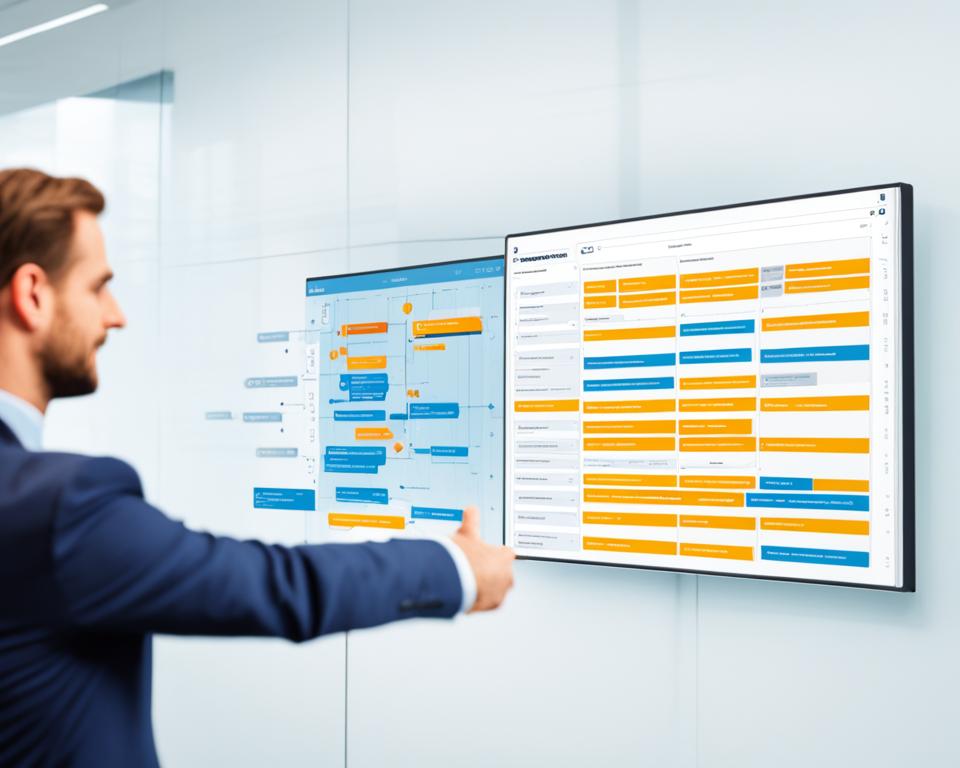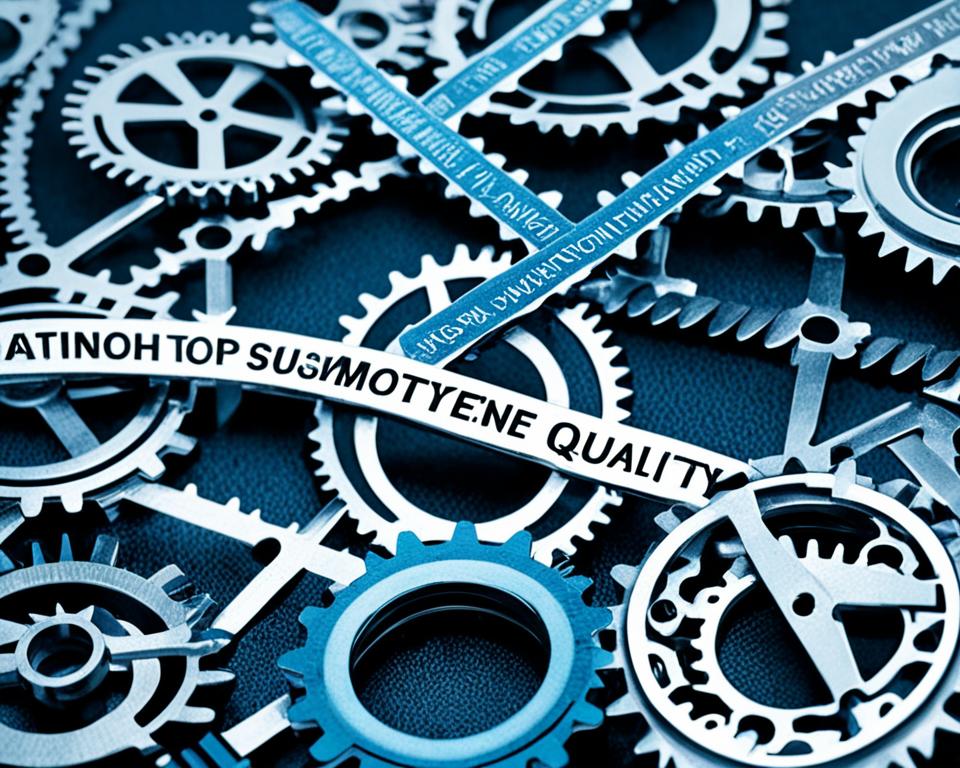Ever thought about how your business can lead in quality management? SAP xCQM, or Extended Collaborative Quality Management, offers a new way to improve your quality processes. It’s perfect for today’s businesses facing tough rules and changing markets. This platform brings together quality checks, defect tracking, and supplier management to keep your quality high.
Using SAP xCQM boosts your efficiency and encourages ongoing improvement. This is key for your business’s long-term success. As we dive into its features, you’ll see how it changes the game in quality management for your company.
Key Takeaways
- SAP xCQM offers integrated solutions for quality management.
- Enhances efficiency in quality control processes.
- Facilitates effective defect tracking mechanisms.
- Supports robust supplier management practices.
- Promotes a culture of continuous quality improvement.
- Adapts to regulatory pressures and market demands.
Understanding SAP xCQM
SAP xCQM is a key tool for quality management software. It helps teams work together better by creating a central place for quality goals. This way, everyone knows what the goals are and can work together more smoothly.
SAP xCQM works well with other SAP systems, making things easier and more efficient. This means companies can improve their quality efforts without dealing with hard-to-use software. It’s all about making things simpler and more effective.
Today, quality management must work with other business areas like procurement and supply chain. SAP xCQM helps connect these areas, leading to better decisions with up-to-date data. For more on how SAP xCQM can help, check out the features of SAP Ariba. SAP Ariba offers tools that work well with SAP xCQM.
The Importance of Quality Management in Business
The importance of quality management is huge in today’s competitive world. Companies that focus on quality do better with customers and run smoother. They also follow the rules of their industry.
By focusing on quality, I’ve seen big benefits. For example, companies with strict quality standards use less resources and make more money. They also avoid big fines by following the rules.
Real examples show how key quality management is for success. A study found that companies with good quality programs keep more customers. This means they save money and look better to customers.
In short, quality management is key for business success. Companies that care about quality do well and keep doing well. For more on making SAP development better, check this out.

Key Features of SAP xCQM
The SAP xCQM features are key to improving quality management in companies. They make it easy for teams to use the system, boosting efficiency. This ease of use helps spread good practices across departments, making work smoother.
Being able to work on the go is another big plus. Users can check quality, add data, and start workflows from their phones. This lets teams quickly handle quality issues as they happen.
Real-time analytics help make quick decisions by offering up-to-the-minute quality info. Companies can keep an eye on how well they’re doing and the health of their assets. This helps them fix problems early, preventing bigger issues later.
One of the best things about SAP xCQM is how well it works with other systems. It connects easily with SAP modules and other apps. This lets companies tailor their quality management to fit their needs, following industry rules and best practices. The strong integration boosts how well the organization works together.
Quality Control with SAP xCQM
In today’s competitive world, having good quality control is key for making top products. SAP xCQM offers many ways to make quality control better. It uses statistical process control, checks, and keeps an eye on things to keep standards high.
Automated workflows in SAP xCQM make quality control easier. They cut down on human mistakes, making things more reliable. With fast data analysis, problems can be fixed early, keeping quality up.
Here’s a table that shows what SAP xCQM offers for quality control:
| Quality Control Method | Description | Benefits |
|---|---|---|
| Statistical Process Control | Monitors and controls process variations. | Ensures consistent quality and reduces waste. |
| Inspections | Systematic assessment of products against standards. | Identifies defects early, preventing costly rework. |
| Monitoring Processes | Continuous oversight of production activities. | Facilitates quick responses to quality deviations. |

Using these methods in SAP xCQM helps improve things over time. It lets businesses make better products, save money, and make customers happier.
Defect Tracking Made Easy
In today’s fast-paced business world, keeping up with defect tracking is key for quality. SAP xCQM makes this process smooth and efficient. It has an easy-to-use interface that helps spot, record, and fix defects.
SAP xCQM is great at reducing production delays. It lets companies fix problems early, keeping quality high. This saves time and boosts team productivity.
| Feature | SAP xCQM Defect Management | Traditional Methods |
|---|---|---|
| Ease of Use | User-friendly interface | Complex and time-consuming |
| Response Time | Real-time notifications | Delayed response |
| Efficiency | Streamlined processes | Multiple manual steps |
| Data Analysis | Comprehensive reporting tools | Lack of analytical capability |
| Issue Resolution | Proactive engagement | Reactive measures only |
This table shows how SAP xCQM is better for handling defects. It lets companies quickly solve problems, keeping quality first in all operations.
Enhancing Supplier Quality Management
In today’s market, having a strong supplier quality management plan is key. SAP xCQM offers tools for smooth talks and teamwork with suppliers. With SAP xCQM supplier features, I can better manage vendor checks and keep an eye on how they’re doing.

SAP xCQM shines with its smart analytics for checking supplier performance on the spot. These tools help me spot risks early and fix them before they become big problems. Adding these tools to my quality plan helps improve supplier relationships and boosts business success.
Automated reminders and alerts from SAP xCQM make checking on suppliers easier. The system keeps track of who’s following the rules, helping me take quick action when needed. This keeps the supply chain focused on quality and responsibility.
| Feature | Benefit |
|---|---|
| Real-time Analytics | Helps make smart choices about how suppliers are doing. |
| Automated Alerts | Keeps ahead of compliance issues and risks. |
| Vendor Assessment Tools | Makes checking quality easier, improving control. |
Using SAP xCQM’s new features in my supplier quality management helps protect product quality. It also builds stronger partnerships with suppliers, which grows the business. For more on SAP and its uses, check out this useful resource.
Effective Nonconformance Management
Using SAP xCQM for nonconformance management changes how companies deal with quality problems. It makes finding, documenting, and fixing issues with products and processes easy. I’ve seen how SAP xCQM simplifies this process step by step.
The key steps in managing nonconformances are:
- Identification: Spotting when a product or process doesn’t meet standards.
- Documentation: Writing down the details of the issue for better analysis.
- Analysis: Finding out why the issue happened to stop it from happening again.
- Resolution: Fixing the problem and checking if the fix works.
- Review: Always checking processes to find ways to get better.
This method not only fixes current quality problems but also lowers the chance of future ones. SAP xCQM’s tools help make quality management better, encouraging ongoing improvement in the company.
Quality Assurance Through SAP xCQM
In today’s market, quality assurance is key to staying ahead. It helps improve processes and make customers happy. By using SAP xCQM for quality assurance, I can make my operations smoother and get better results.
What is Quality Assurance?
Quality assurance is about making sure products and services meet certain standards. It’s vital for spotting problems before they start, which lowers risks and boosts reputation. With SAP xCQM, it’s all about making things better over time. This keeps us in line with rules and meets what customers want.
Benefits of Quality Assurance in SAP xCQM
Using SAP xCQM for quality assurance brings big benefits to businesses. Here are some main advantages:
- Higher Customer Satisfaction: Better products and services mean happier customers who stick around.
- Enhanced Compliance: Helps companies follow the rules and avoid fines.
- Continuous Quality Improvement: Sets up a way to always make things better.
Real examples show that SAP xCQM can really boost performance. By tackling quality issues smartly, companies can save money and make their supply chains run smoother. Case studies prove that a strong quality assurance plan can cut costs and improve efficiency.

| Benefits | Description |
|---|---|
| Cost Savings | Lower costs by making processes more efficient and managing resources well. |
| Efficiency Improvements | Workflows get smoother and automation cuts down on manual tasks. |
| Better Supplier Relationships | Improved talks and teamwork build trust and reliability with suppliers. |
| Data-driven Decisions | Use analytics to make smart choices in sourcing and procurement. |
The benefits of SAP xCQM quality assurance go beyond just now. They set the stage for lasting success and sustainability in my business.
Leveraging CAPA (Corrective and Preventive Actions)
Understanding CAPA is key to a strong quality management system. It includes both corrective and preventive actions. Corrective actions fix issues after they happen. Preventive actions stop problems before they start. This way, organizations tackle current issues and prevent future ones.
SAP xCQM offers tools to make CAPA easier. It helps track nonconformities and find their root causes. The system supports fixing problems as they come up. It also helps prevent them from happening again.
An effective CAPA process has several important parts:
- Identification of Issues: Quickly spot defects or failures that need attention.
- Root Cause Analysis: Use deep analysis to find the real reasons behind problems.
- Action Implementation: Carry out specific actions to fix the issues.
- Effectiveness Review: Check how well actions worked and make changes if needed.
- Documentation: Keep detailed records of all actions, ensuring accountability.
SAP xCQM’s structured CAPA approach helps my organization keep high quality and follow rules. It prevents costly or damaging issues. By using these tools, I can keep improving my organization.
| CAPA Component | Description | Benefits |
|---|---|---|
| Corrective Actions | Actions taken to correct existing defects. | Immediate resolution of issues. |
| Preventive Actions | Strategies implemented to prevent future occurrences of issues. | Reduces risk and increases efficiency. |
| Root Cause Analysis | Investigation aimed at identifying the primary cause of problems. | Prevents recurrence of issues. |
| Documentation | Recording of all actions and analyses performed. | Ensures transparency and accountability. |
Streamlining Inspection Management
In today’s fast-paced world, managing inspections well is key to keeping quality high. SAP xCQM inspections are a great tool for this. They help organizations improve their quality control by automating inspections. This makes sure evaluations are thorough and consistent.
SAP xCQM shines with its detailed reporting features. These reports give insights into what’s working and what needs work. This lets organizations make smart choices based on data quickly.
- Automation: It cuts down on manual work and boosts accuracy.
- Standardization: Makes sure inspections are the same everywhere.
- Real-time Monitoring: Offers quick feedback and lets you adjust on the fly.
- Data Integration: Keeps all info in one place for easy access and review.
Some key features of SAP xCQM for managing inspections include:
| Feature | Description |
|---|---|
| Customizable Checklists | Allows for tailored inspection criteria based on specific needs. |
| Performance Metrics | Tracks important indicators of inspection efficiency. |
| Integration with Quality Control | Connects inspection results with quality assurance steps. |
| User-friendly Interface | Makes it easy for everyone involved in inspections. |
Using these features, I can greatly improve the quality and efficiency of managing inspections. SAP xCQM inspections help create a culture of ongoing improvement. This is vital for keeping up with changing industry standards.
Comprehensive Audit Management
In my look at audit management with SAP xCQM, I see how the system is great at planning and doing audits well. It helps companies keep track of rules and handle findings well. Knowing how important it is to follow is key today, and SAP xCQM audits help with that.
The system makes work flow smoothly, letting companies check on rules and improve their quality systems. It has great tracking and reporting tools, making audits easier to manage. This lets companies fix compliance problems before they get worse.
Here are some key features that show how SAP xCQM is good at managing audits:
| Feature | Description |
|---|---|
| Audit Planning | Helps in developing comprehensive audit schedules aligned with regulatory requirements. |
| Compliance Tracking | Monitors adherence to industry standards and internal policies effectively. |
| Finding Management | Streamlines the documentation and resolution of audit findings to ensure corrective actions are implemented. |
| Reporting Capabilities | Generates detailed reports which support informed decision-making and strategic improvements. |
When SAP xCQM works with other systems, like Ariba, it makes managing audits even better. It gives a full view of how things work in procurement and following rules. This helps companies keep up with strict standards and do well in a world focused on following rules.
Quality Planning with SAP xCQM
Quality planning is key to running a business well. Using SAP xCQM makes it easier to match quality goals with business aims. This way, I can make sure everyone knows what to do and work better together.
Creating a Quality Plan
First, I look at what my business needs. Then, I set clear quality goals and define how to measure them. SAP xCQM helps me make quality plans that fit these goals. Here’s how:
- Identify quality objectives based on customer needs and rules.
- Collect data to set quality standards and metrics.
- Use SAP xCQM to make a detailed quality plan.
- Define who does what in the quality team.
- Check and update the quality plan as needed.
Integrating Quality Planning into Business Processes
Putting quality planning into daily work is key to doing well and getting results. Using SAP xCQM in my work makes sure quality is always in focus. This leads to:
- Quality goals that match with the company’s plans.
- Quality performance seen across all departments.
- Better sharing of quality goals among team members.
- More responsibility in meeting quality standards.
Knowing how important quality planning is and using SAP’s tools can really boost quality and efficiency in my company. For more on managing data integrity, check out the ABAP Dictionary in SAP development. It’s crucial for managing data well.

Real-world Applications of SAP xCQM
SAP xCQM has changed the game for many companies across different fields. SAP xCQM case studies show how quality management tools make a big difference in daily business. Companies see better quality control, work more efficiently, and perform better overall.
A top manufacturing firm used SAP xCQM to make quality control easier. They cut their defect rate by 30% after using it. This led to big cost savings and happier customers. Their story is a common one in the world of quality management.
A pharmaceutical company also turned to SAP xCQM for help with rules and audits. They not only met all the rules but also sped up their audits by 25%. Using strong quality tools made sure their products were safe and worked well.
The following table summarizes key outcomes from various SAP xCQM case studies:
| Company | Industry | Improvement | Percentage Change |
|---|---|---|---|
| Leading Manufacturing Co. | Manufacturing | Defect Rate Reduction | 30% |
| Pharmaceutical Firm | Pharmaceuticals | Audit Cycle Improvement | 25% |
| Food Processing Ltd. | Food Industry | Product Quality Enhancement | 40% |
| Automotive Corp. | Automotive | Supplier Quality Management | 20% |
These stories show how SAP xCQM helps different sectors in big ways. My look into quality management applications confirms that focusing on quality can lead to big wins for companies.
Conclusion
SAP xCQM is changing the way we manage quality today. It brings together different quality checks, making it easier to track defects and manage suppliers. This tool shows how important technology is for the future of quality management.
Organizations using SAP xCQM are leading the change in quality management. They get to work better, meet standards, and make customers happy. This focus on always getting better is key to doing well in today’s market.
In our digital world, I suggest looking into SAP xCQM for your business. Using this technology can make your operations better. It leads to better products, smoother processes, and a strong quality management future for everyone involved.
FAQ
What is SAP xCQM?
SAP xCQM stands for Extended Collaborative Quality Management. It’s a tool designed to make quality management better. It helps with tracking defects, managing suppliers, and handling nonconformances.
How does SAP xCQM improve quality management in businesses?
SAP xCQM brings together many quality control functions in one place. This makes communication better among teams. It also lets you watch quality processes in real-time and aligns quality goals with business aims. This leads to better quality assurance.
What are the key features of SAP xCQM?
SAP xCQM has a user-friendly interface and works on mobile devices. It offers real-time analytics for tracking quality. It also works with other SAP tools and third-party apps. It supports inspection, audit management, and quality planning.
How does defect tracking work in SAP xCQM?
SAP xCQM makes tracking defects easy with its intuitive system. Users can quickly find, document, and fix defects. This helps reduce production issues and keeps quality high.
Can SAP xCQM assist with supplier quality management?
Yes, SAP xCQM helps with supplier quality management. It makes communication and collaboration with suppliers better. It has tools for checking vendors, monitoring them, and ensuring product quality in the supply chain.
What is nonconformance management, and how does SAP xCQM address it?
Nonconformance management is about finding and fixing quality standard deviations. SAP xCQM helps with this by offering workflows for documenting and solving nonconformances. This leads to ongoing quality improvement.
Why is quality assurance important in SAP xCQM?
Quality assurance is key for staying excellent in operations. SAP xCQM ensures quality practices are followed. This boosts customer satisfaction, improves compliance, and drives quality improvement.
What does CAPA mean, and how does it relate to SAP xCQM?
CAPA means Corrective and Preventive Actions. SAP xCQM uses CAPA to tackle root causes of problems and prevent future issues. This ensures a proactive quality management approach.
How does SAP xCQM facilitate inspection management?
SAP xCQM makes inspection management easier and more efficient. It supports different inspections and offers reports for better insights into results.
What role does audit management play in SAP xCQM?
Audit management in SAP xCQM helps plan, do, and track audits well. It manages findings and ensures compliance with laws. This improves quality systems in the company.
How can businesses integrate quality planning with SAP xCQM?
Businesses can make a quality plan in SAP xCQM by following steps to match quality goals with business aims. This integration makes everyone accountable and keeps quality standards consistent across processes.








